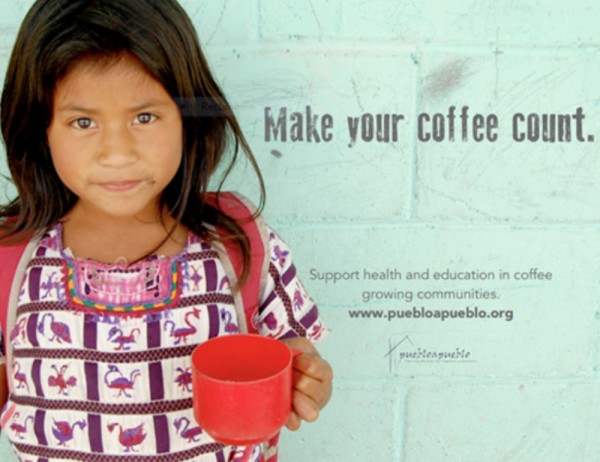Donate X amount per X sold for X cause.
It’s a simple enough formula, even an intuitive one in the case of giving back to coffee-producing communities, but filling in those Xs is easier said than done.
“As a small business, you can get wrapped up in your daily operations over a long period of time, and it can be very easy to lose sight of the bigger picture,” says Mark Warmuth of ME Swing Coffee, a nearly 100-year-old Washington D.C.-area roastery with an upscale shop a stone’s throw from the White House.
In other words, seeking out someone’s name to write on the “pay to the order of” line of a check may not always be top priority.
As with almost anything in coffee, charitable collaboration is driven by relationships. Swing is in close proximity to the headquarters of Pueblo a Pueblo, a nonprofit whose primary focus is sustainable health and education for children in coffee-farming communities in Guatemala.
Pueblo a Pueblo last year reached out to ME Swing with a broad idea for a kind of pilot partnership. Nearly a year later, the result was a more than $2,500 donation, the ability to send nine children in Guatemala to school and provide for their basic healthcare needs, and the immeasurable value of awareness among Swing’s customers. All this with little to no additional investment or work from the coffee company, outside of some barista training regarding the collaboration and some bean counting.
“The easy thing to do would be to write a check for $500 or $1000, and we could be happy with it, but we talked about a way to kind of create more awareness,” Warmuth says of a casual meeting with the Pueblo a Pueblo staff during the SCAA Event in Seattle last year.
The collaboration a two-week window during which 10 percent of revenue from all cups of coffee and bags of coffee sold by Swing were collected for a specific Pueblo a Pueblo school program. Additionally, customers could choose to match the 10 percent donation by buying a bag of coffee with a Pueblo a Pueblo sticker. A small informational station on the fundraising program was set up near the coffee bar, and Swing made a conscious decision not to promote any kind of donation jar, so as not to take tips away from baristas.
In two weeks, Swing sold 929 bags and 5,842 cups of coffee, and about 1/3 of the total donation amount ($2,566) came from transactions where the customer kicked in a 10 percent match.
While such success may be duplicated, the models through which it is achieved may not always be.
“More and more, we’re seeing coffee companies that want to give back, and they want to contribute, but often they don’t know how,” says Pueblo a Pueblo Executive Director Rosemary Trent. “We try to work with each person we reach out to in a way that works for them. So what we do with Swing might not work with another coffee business.”
The Swing collaboration was actually one of Pueblo a Pueblo’s first involving direct outreach with roaster/retailers. The first was with D.C.’s Peregrine Espresso, and Trent says more collaborations may follow as the nonprofit focuses on connecting to consumers through coffee.
“In terms of dollars, it wasn’t huge,” Trent says of the collaboration. “But it it gave us lots of exposure. I think there’s a push to engage consumers more, and we envision this kind of collaboration as one way to do that.”
Says Pueblo a Pueblo Resource Development Manager Claire Dickson, “The partnerships with Swing and Peregrine were sort of the beginning. When you have more campaigns running back to back, then the dollar amount really starts to add up. We’ve been testing the waters, and the response has been great.”
Of course, what works for Swing and Pueblo a Pueblo might not work for X coffee company and X nonprofit. Trent notes that some coffee companies may be drawn to broader fundraising efforts, while others may only be interested in donating to programs tied to a specific farm or cooperative, something that may or may not always be practical at origin.
“We really do have a core strength,” Trent says. “We don’t profess to do anything and everything. For us, it’s kind of second nature what we do on the ground. We always talk about trickling down for these kinds of efforts, but it’s also about trickling up.”
Nick Brown
Nick Brown is the editor of Daily Coffee News by Roast Magazine.
Comment
1 Comment
Comments are closed.







Charity is okay. I really prefer the old saying of teaching to fish is a lot better that giving out one fish (Chinese?). Collecting donations, then finding someone in need and simply giving out money, is a lot of wasted resources and, the end product is teaching the poor person that there will always be someone who will give money. Next time, poor people will simply extend their hands and request charity. The REAL way to do things is to pay fair prices to farmers for their hard, back-breaking toil of every day. Instead of giving out a few dollars once or twice a year, pay fair and prompt, so the farmer can live better, send their kids to school and get proper health care. Funny how industrial countries tend to be “generous” with charity but stingy when buying and, also demanding higher prices for their products.